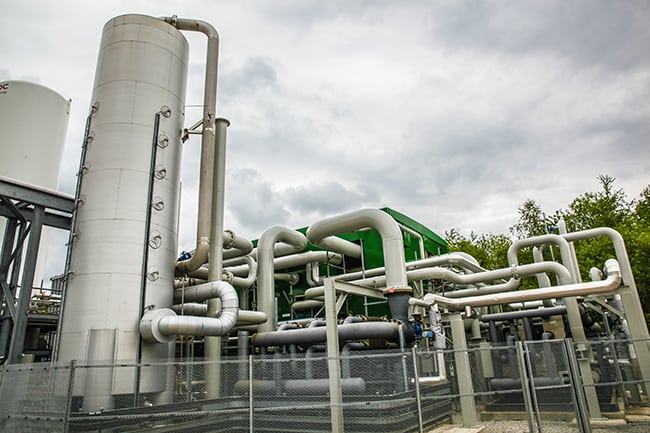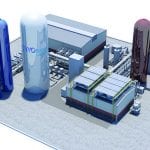The world’s first grid-scale demonstration of a liquid air energy storage (LAES) plant was officially launched in June.
UK-based long-duration energy storage firm Highview Power developed the 5-MW/15-MWh project in partnership with recycling and renewable energy company Viridor with more than£8 million in funding from the UK government. The plant located at the Pilsworth landfill gas site in Bury, near Manchester, in the UK (Figure 4), works by using surplus power (during off-peak hours) to refrigerate air into a liquid at –196C (–320F).
The liquid air is then stored “very efficiently” in insulated tanks at low pressure. When power is required, liquid air is drawn from the tanks. Exposure to ambient temperatures causes rapid re-gasification and a 700-fold expansion in volume, which is then used to drive a turbine and create electricity without combustion. “Heat harnessed from the liquefaction process is applied to the liquid air via heat exchangers and an intermediate heat transfer fluid. This produces a high-pressure gas in the form of air that is then used to drive the turbine and create electricity,” Highview Power explained.

The company says the technology draws from established processes from the turbo-machinery, power generation and industrial gas sectors. Components used in the processes “can be readily sourced from large OEMs [original equipment manufacturers] and have proven operating lifetimes and performances,” it said. The technology doesn’t depend on “exotic materials” like battery storage and is comprised mostly of steel, giving it a lifespan of between 30 and 40 years, in comparison with 10 years for batteries. At the end of its life, an LAES plant can be decommissioned, and the steel can be recycled. And because the system uses a thermodynamic cycle, it can interface with co-located thermal processes such as liquefied natural gas regasification plants, peaking plants, and industrial applications. “This means we can utilize waste heat and cold streams, improving the efficiency of our customers’ main processes by converting their waste thermal energy into a useful resource for our system,” it said.
According to Gareth Brett, Highview Power’s vice chairman (and CEO of the company for 10 years before Dr. Javier Cavada Camino took on that role on June 28), completion of the grid-scale plant is a major milestone in demonstration of “the only large scale, true long-duration, locatable energy storage technology available today, at acceptable cost.” The project was preceded by a 350-kW/2.5-MWh pilot installation at SSE’s biomass plant at Slough Heat and Power in Greater London. The pilot underwent full testing between 2011 and 2014, before it was relocated to the University of Birmingham Center for Cryogenic Energy Storage to support further testing and academic research.
At the Bury plant, where demand response aggregator KiWi Power draws energy—and generates revenue—to power 5,000 average-sized homes for around three hours, Highview Power will demonstrate how LAES can provide reserve, grid-balancing, and regulation services.
Yet, the opportunity is far greater, Brett noted. LAES technology can scale to hundreds of MWs in line with energy demand of large cities. “The market opportunity for LAES technology is exciting—we estimate that 60% of the global energy storage market comprises long-duration, grid-connected storage and that our LAES technology is ready to meet almost half of this (45%),” said Brett.
Brett added that “utilities from around the world” have been assessing Highview Power’s solution. “We are therefore already in detailed negotiations to build plants ten times the size of this one for utility customers of several nationalities and for various different applications,” he said.
—Sonal Patel is a POWER associate editor.










